Ace Thailand-based wreck-investigator TIM LAWRENCE led an expedition to Brunei recently, carrying an Explorers Club pennant, in a bid to track down a Japanese WW2 destroyer sunk by an intrepid Dutch pilot more than 80 years ago. Would his quest succeed?
17 December, 1941
Commander Vrijburg inspected his Dornier flying-boat. Flashing his torch around the wings, the Dutchman checked for rust, an ever-present danger to these unlikely birds.
The three engines over the wing rendered the aircraft’s outline unmistakable. The Dornier Do24K-1 formed the backbone of Vrij’s small Royal Dutch Naval Air Group tactical unit GVT-7, stationed at Tarakan in northern Borneo. This was one of 18 secondary bases around the Dutch East Indies, tasked with anti-submarine patrol, reconnaissance and convoy escort duties.
Vrij had his hands full in those troubled times. The German-built seaplanes were big, sluggish and heavy to steer. They also lacked radar, forcing pilots to rely heavily on topography to navigate.
He hoped his gunners were well-rested. Low-lying clouds forecast over the target area would help to mask his planes’ approach, but could make it challenging to locate the invasion force. Even so, Vrij was content with these odds.
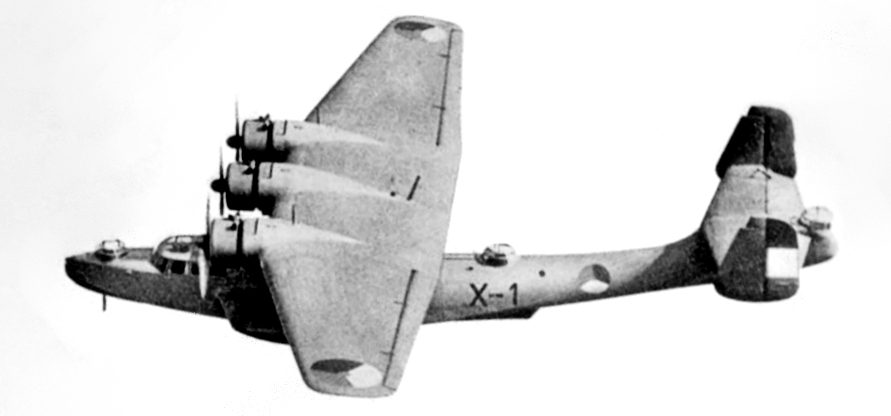
Japanese landings in British Borneo the previous day had gone largely unopposed. The fragmented British land force, made up mainly of ethnic tribes commanded by Lt-Colonel CM Lane, had been no match for 2,500 crack Japanese troops motivated by necessity.
The Americans had cut 80% of Japan’s fuel supplies since the attack on Pearl Harbor, and the danger of their invasion grinding to a halt was a real one. But all the British could do to stop them for now was to sabotage the oil refineries, and retreat.
Japanese ships could always use unrefined light crude oil from Borneo, but their crews knew that its sulphur content would promptly render their boilers unserviceable, as a result of metal fatigue.
The Japanese plan was brilliantly simple, however: to use overwhelming force to take control of the air, then strategically land troops to seize refineries and small airfields. Repeating this pattern, they would leapfrog along the coastline until all the oil in Borneo was at the service of the Japanese empire.
Bloody nose
They had under-estimated the stubbornness of the Dutch. Vrij signalled through his cockpit’s side-window to the other GV7 planes waiting on the water. The noise was deafening. He faced his sea-plane into the wind and gunned its engines. The flutes on the hull began to lift the heavy aircraft.
Slowly it rose from the water, until only the bottom skipped across the small wavelets. The sluggish hull broke free and began to clear the surface like an albatross, slowly at first, the water residue clinging to its wings as it freed itself from the sea’s grasp.
Vrij sat back, letting the low-lying cloud engulf his plane. He turned his attention to the instruments. Determined to give the Japanese a bloody nose, he had to locate their convoy.
Maintaining radio silence to avoid giving away his strike group’s position, he monitored the airwaves to see if he could capitalise on an earlier bomber attack. Each of his aircraft carried the maximum payload of six 200kg bombs, and the weight would slow their climb to 4,500m.
The skies were clear at altitude. The sun shone brightly, contrasting with the overcast morning at sea level. The look-outs scanned the clouds below, looking for a clearing that might help betray the position of the landing force.
Time passed – then a break in the cloud betrayed a surface ship, the foamy wake pointing towards it like an arrow. Vrij adjusted his course to follow it.
Fog of war
Far below, Commander Sasagawa Hiroshi gazed out from his bridge towards the horizon, lost behind the clouds.
His Fubuki-class destroyer, IJN Shinonome, had arrived at the location that morning and he had carefully positioned it north of Kuala Baram. Hiroshi was confident. The landings the day before had gone well and the destroyer, bristling with armaments, filled him with pride.
The technological advances his compatriots had crammed into the ship since the keel was laid in 1927 were the envy of many modern navies. Even so, he would be happier if he could see where that aircraft-engine drone was coming from.
Far above, Cdr Vrijburg unleashed five of his 200kg bombs. His plane lurched as it was released from the weight. A single bomb remained attached, so Vrij engaged the lever one more time before turning for home, sure that Japanese aircraft would soon locate his group if they hung around.
Below, an eruption of water shattered the faint hum of aircraft engines and swamped Hiroshi’s warship. The commander had no time to respond, as two more bombs detonated in quick concession behind the aft gun-turret and in the magazine, sending a plume of debris 200m into the sky.
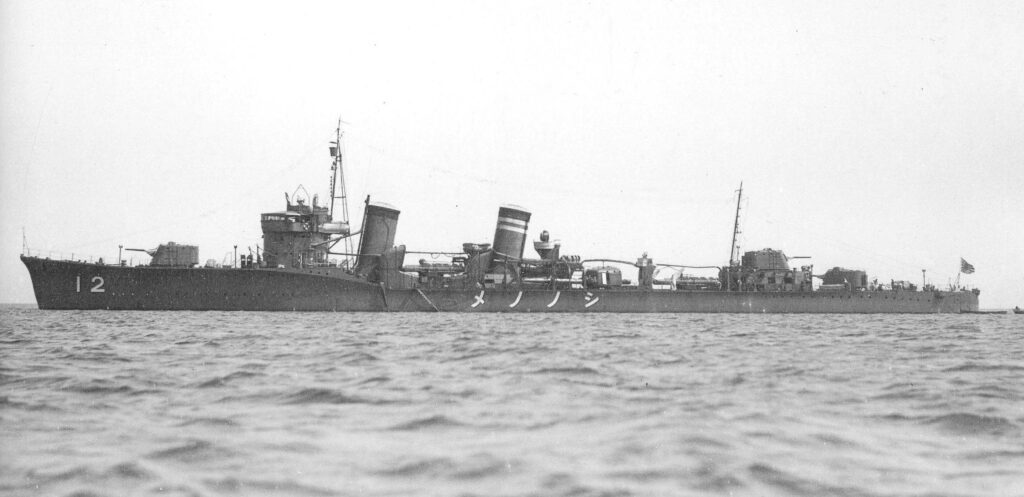
Immediately aft of the chimney stack, with two hits out of five, part of the ship was beginning to settle. Men not killed in the initial explosion opened fire wildly into the clouds. Hiroshi looked on in disbelief, his pride shattering around him.
Above, another break in the clouds revealed the scene below. The suffering seemed strangely detached, balanced against the engine hum. Vrij watched the destroyer enter its death-throes.
The men scrambled about, overwhelmed by the speed of events. The only witness was above, hurriedly leaving the scene in the hope of avoiding reprisals. All hands were lost.
Look-outs on the closest ship, Hiyoshi Maru a mile away, had failed to see the air attack because of the cloud cover but, having heard the explosion, later attributed the sinking to a mine.
Vrij returned to base and put in his report but, as often happens in the fog of war, the details became woven into alternative accounts, some of which had the ship sinking the following day. Other records placed a cruiser into the air-attack story.
The years passed, and the story was lost. So what happened to the INJ Shinonome and her 220 seamen?
13 April, 2023
Warm welcome

Modern Brunei, flushed with oil wealth and under Sharia law, could not offer the lubricants I usually count on as essential to a successful expedition. The heavily subsidised citizens find other ways to wash down the bitter pills of life, so we had to make do with some syrup whisky purchased on the border and declared on entry – albeit frowned on by the local guardians of piety.
However, running the gauntlet and entering the country flipped the narrative entirely, with our team receiving a warm welcome from both the expat community and the locals. Brunei BSAC, headed by Mike Tong, gave us the keys to the clubhouse, a considerable gesture. Another local, Stuart Savage, also went above and beyond, joining the team to provide valuable research.
We got to work blending gas and reconfiguring our equipment before turning in early. We spent the next day working up equipment and local procedures on the wreckage of a 1970s tug, then headed out the following day for the main event.
All we had to go on was the original war-record report from the air attack 15 nautical miles north of Point Kuala Baram. Two approximate positions were marked on the charts, though an oil-company survey had made no mention of any anomalies in these areas.
Recording these locations gave us a starting point but it was a vague one. I was keen to speak to local fishermen, and our captain agreed to speak to one of them, who happened to be his uncle. Whisky is my usual currency for enlisting local help but, with this off-limits, I found that the promise of coffee fell sadly short.
However, we did get two new anomalies to investigate from the helpful uncle, and headed out to the first one. It took only minutes before a significant return appeared on our screens.
Our two dive-teams prepared themselves quickly, ready to alternate surface support between them. My group entered first, pausing briefly for bubble-checks before descending into crystal-clear water.
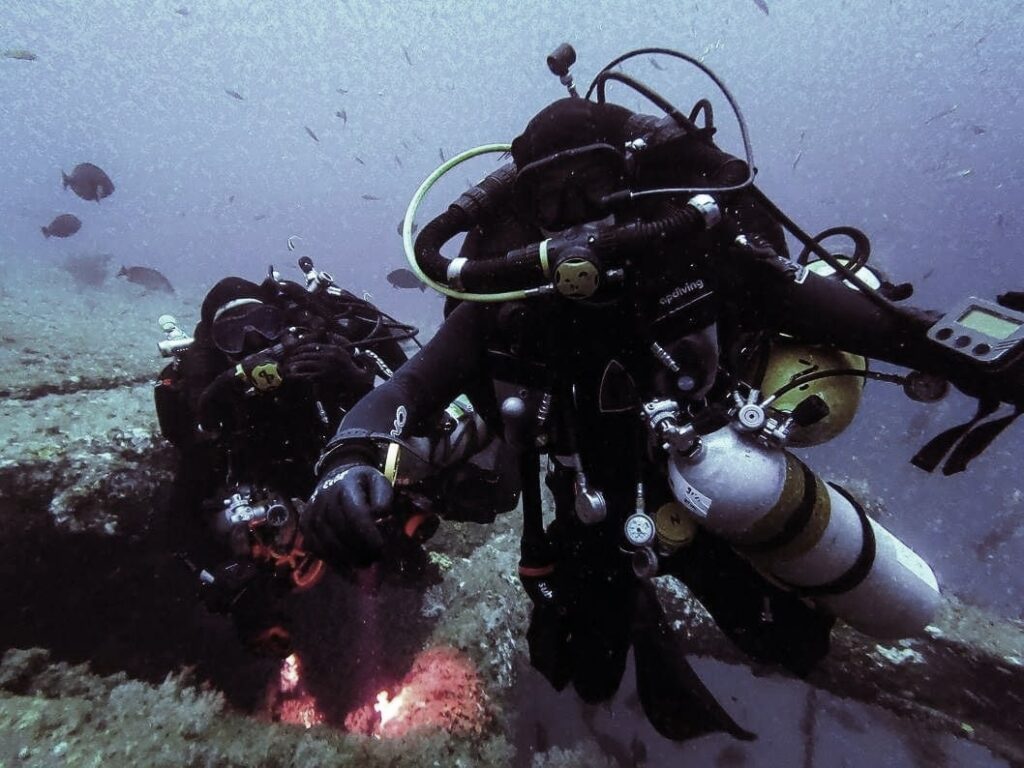
Subduing the urge to rush, we peered intently into the depths. The dark outline of a massive form slowly appeared out of the haze. Was this the Shinonome?
100m reel ran out of line
We searched the structure for signs of gun-mounts or damage from the enormous explosion that had sent the destroyer to Davy Jones’ locker. Sadly, however, the notion that this was the object of our search was quickly dispelled when we saw a modern bridge reach out across the sandy bottom. There had been no reports of any such shipping loss in the area.
We used the rest of our time seeking clues to the identity of what must have been a substantial loss. I ran out of line on my 100m reel measuring the length of the wreck, which had its top at 50m and the bottom at 63m.
Big empty holds and machinery provided a clue to the type of use and direction of travel: three core cables and the design of the superstructure provided an idea of the date of construction. The empty lifeboat-davits testified to the bulk-carrier crew’s timely departure. Good visibility assisted us with everything but a name for the ship!
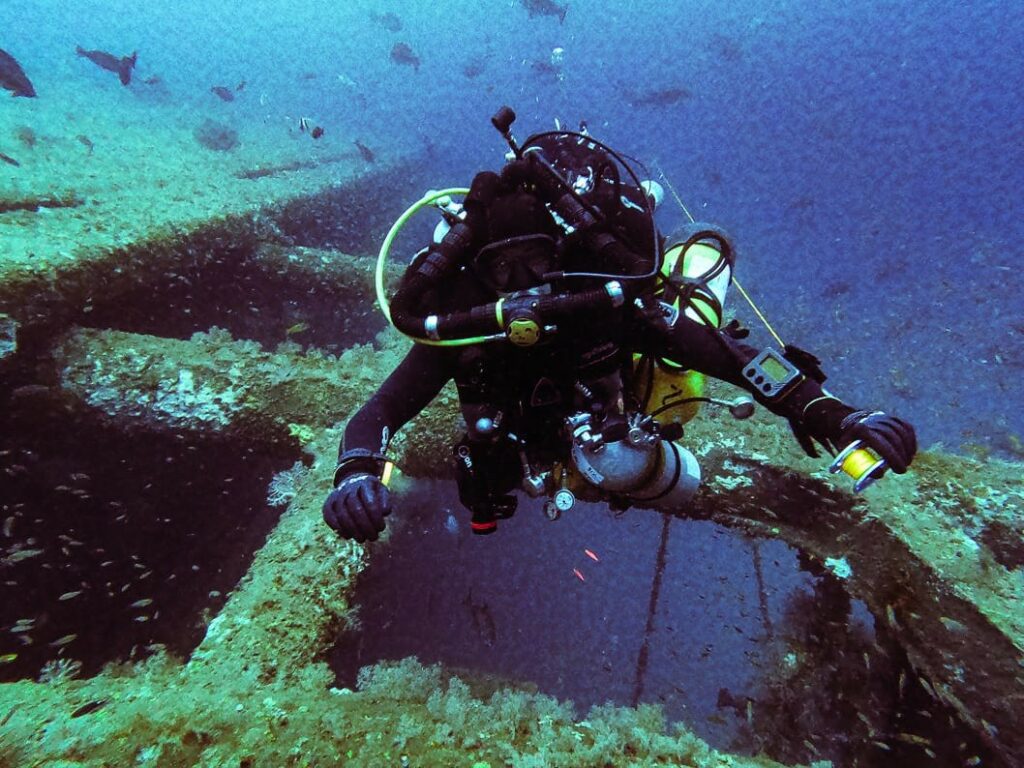
Team B had eagerly awaited our return to the surface and began their own adventure, the warm water helping to simplify our protocols. Stefano Gobbo and Sam Beane ran their profile and returned to the surface 60 minutes later, but still without a name for the bulk-carrier. We returned to port, unable to look further into the ship’s story on this occasion.
Time-constraints meant that we had gas to pump and another anomaly to look at. This one was tantalisingly close to a mark on the charts.
As the evening passed, I wondered what the sailors of 80 years ago would have made of Brunei today. I woke before sunrise, and watched as the light slowly crept towards me. The shadows seemed reluctant to give ground, despite my eagerness to enter the day.
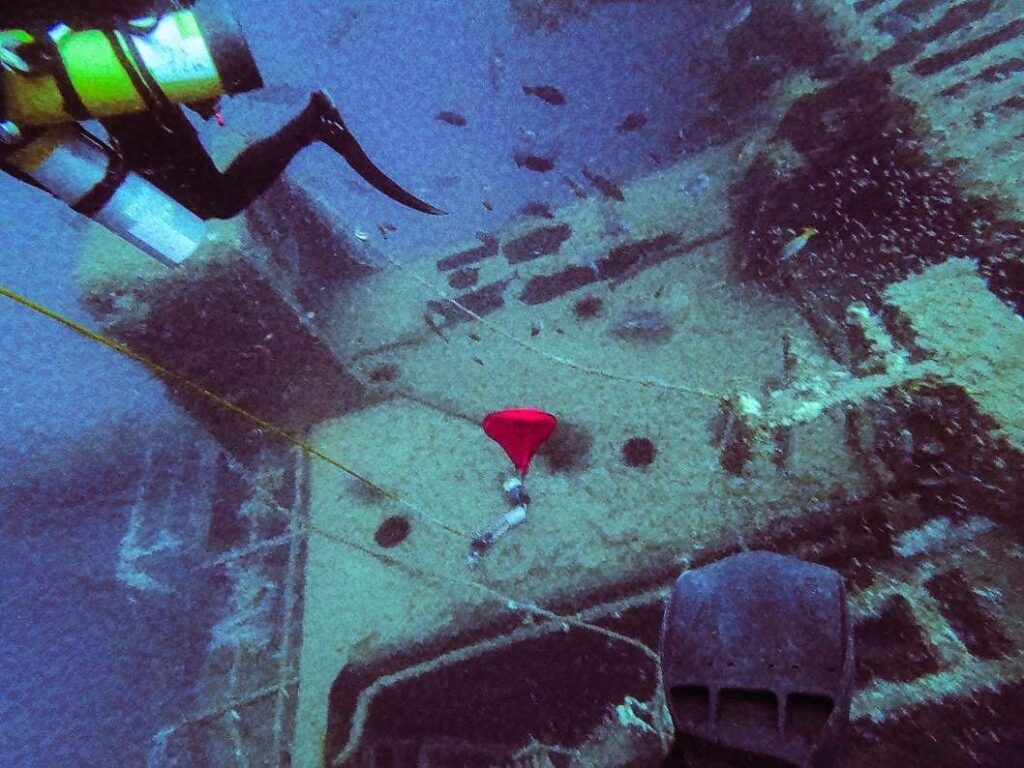
Giant jellyfish
Our boat was fully loaded by 7am and we headed out to our target, just across the border in Malaysian waters. Our Brunei contact Zeed reassured us that Brunei locals crossed to fish regularly but, even so, I recalled days spent running into Gibraltar waters from La Linea in Spain, and we stayed in Brunei waters until the last possible moment before crossing over.
Happily, the mark again appeared to be right on the money, and we hurried into our equipment. We descended through a swarm of giant jellyfish, their presence giving the dive a surreal feeling. A scene from The War Of The Worlds kept flashing through my mind, making me wonder if my helium content was correct.
We ran a distance line at 65m, securing our exit and dropping into the bow section of – an old timber wreck. We passed barrels stacked tightly into the holds, a black sludge visible through missing wooden planking and a large mast lying broken across the deck, and quickly eliminated this wreckage from our search when we reached 70m in the sand. We cut the dive at 20 minutes to contain the penalty.
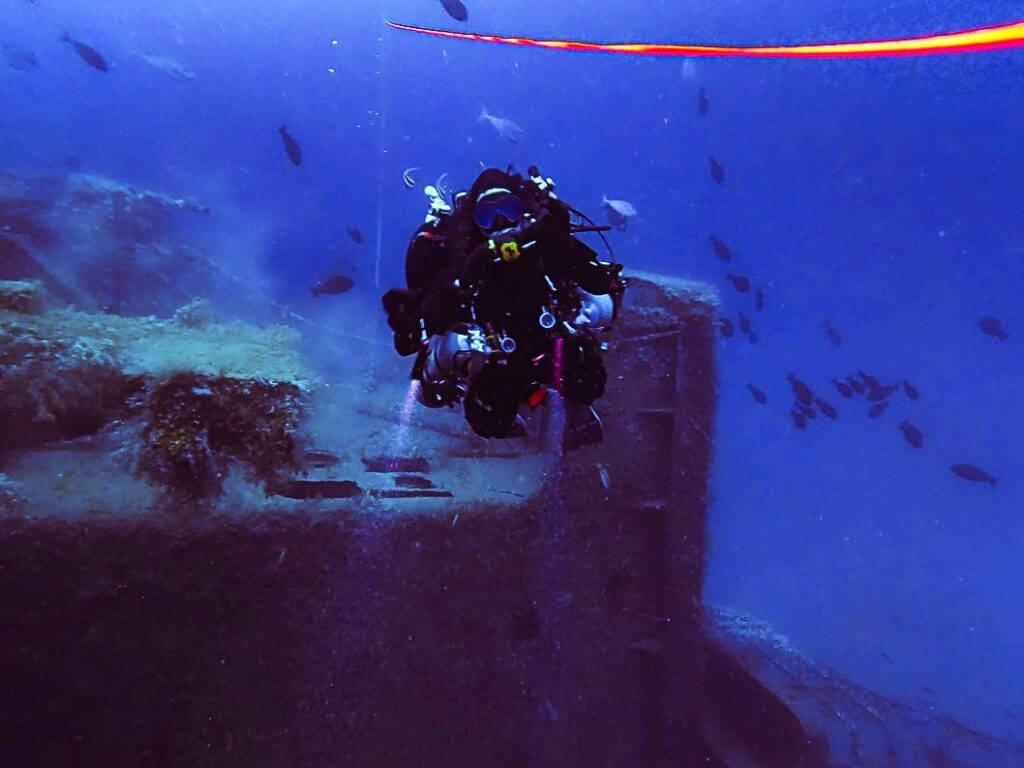
Back at the surface the weather had changed unexpectedly. With the sea-state building, Zeed’s face expressed concern as we headed back.
Our time in Brunei was flying by. We had only two days left but, although the Shinonome continued to elude us, our spirits were high. The following day, we ran out to another fisherman’s mark. Picking up a return, we placed the shotline and readied our gear.
Had we hit something?
I had begun my checks when the coxswain yelped. I looked to the door, where water was breaching the freeboard and threatening to swamp us completely.
We quickly gunned the engines and turned to starboard to lift the opening on the port side out of the water, while closing the door and shifting the weight around the boat. This effort balanced the water rushing to the stern, and gave us time.
The coxswain radioed a Mayday. Dropping my gear and hoping to avoid a surface-swim, I tried to ascertain where all the water had come from. Had we hit something?
Zeed tried unsuccessfully to fix the broken bilge but it had melted. Taking turns, we started bailing out the water by hand, tense looks flashing between us. Nervously, we watched the water level.
Over the next 10 minutes it began to drop. Changing direction, we headed in the direction of the nearest ship before slowly coming off the plane. I wondered if we had compromised the hull above the planing water level, but luckily this was not the case.
Having averted near-disaster, Julien DK jumped into the water to open the self-drainer in the hull before we turned for home, reluctantly leaving our shotline in place. Situations can change suddenly at sea, and the team had reacted brilliantly.
Post-inspection, Zeed and Mike detected a small leak in the fuel tanks, with the gasoline melting the bilge and seals on the self-draining deck to cause, unbeknown to us, a perfect storm. The boat had shipped water over the previous days, slowly reducing the freeboard and leading to the near-disaster.
The day’s excitement was over. We planned our last day’s diving on an older boat, Hammerhead, returning to eliminate the sonar return and recover the shotline before finishing the trip with a dive on the Yoho Maru – but that’s a story for another day.

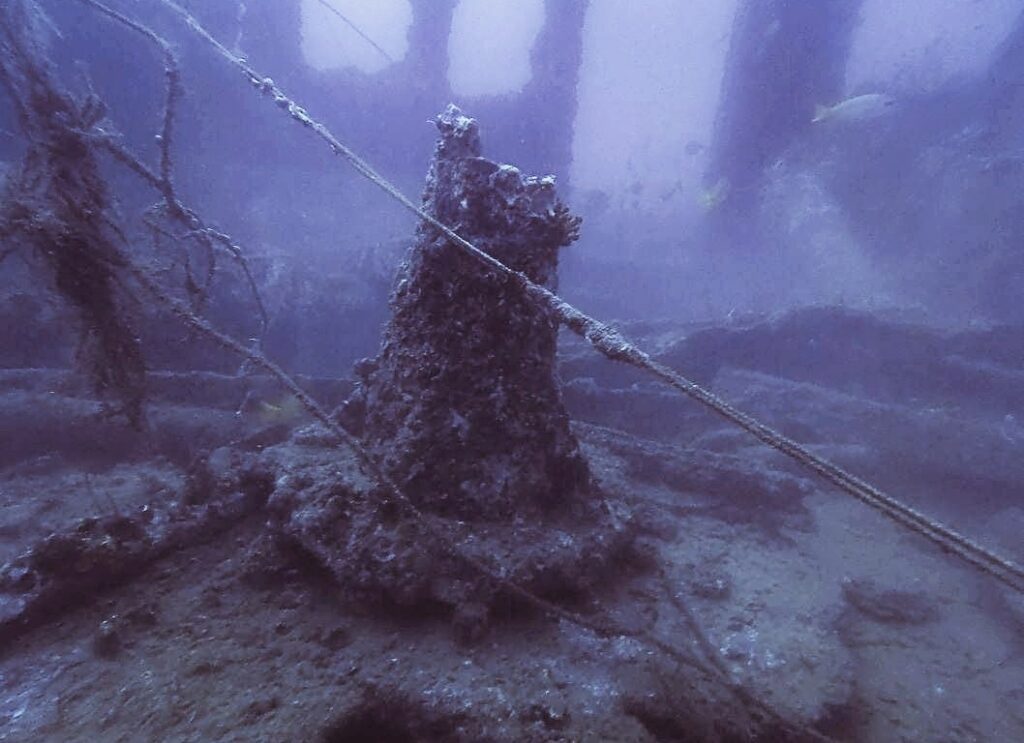
The fate of the IJN Shinonome remains a mystery, waiting to be solved by further expeditions – ours, I hope. Even in the absence of the wreck itself, however, the overwhelming evidence points to Cdr Vrijburg’s attack having brought about the sinking.
Units such as Vrij’s were relocated to the USA after the war, but we believe that he returned to the Netherlands. Our heartfelt thanks to Mike and the team at Brunei BSAC for their fantastic hospitality – and to the Explorers Club for giving us the honour of carrying Pennant 214 on the expedition.
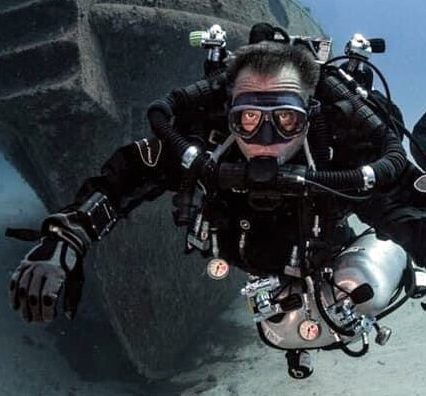
TIM LAWRENCE owns Davy Jones’ Locker (DJL) on Koh Tao in the Gulf of Thailand, helping divers take their skills beyond recreational scuba diving. He also runs the SEA Explorers Club.
A renowned technical wreck and cave explorer, and a member of the Explorers Club New York, he is a PADI / DSAT Technical Instructor Trainer.
BRUNEI TEAM: Mike Tong, Stuart Savage, Phum Siri, Julien DK, Sam Beane, Stefano Gobbo, Tim Lawrence and Zeed
Also by Tim Lawrence on Divernet: Wreck-dive obsession: Brothers in arms, The Ship’s Bell, ’I’d been wreck-hunting when the dive-boat sank’

